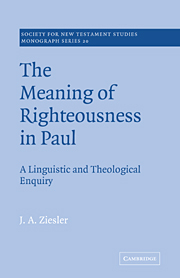Book contents
- Frontmatter
- Contents
- Preface
- Abbreviations
- Introduction
- 1 The Old Testament
- 2 Greek Usage of δíκαιος and cognates
- 3 Later Judaism I: the Septuagint
- 4 Later Judaism II: Intertestamental writings
- 5 Later Judaism III: Philo and Josephus
- 6 Later Judaism IV: The Rabbinic writings
- 7 The New Testament apart from the Pauline corpus
- 8 Paul: Philippians, Colossians, Thessalonians, Ephesians, the Pastorals, and Corinthians
- 9 Righteousness in Christ
- 10 Galatians
- 11 Romans
- Conclusion
- Appendix I Antonyms
- Appendix II The Apostolic Fathers
- Bibliography
- Index of passages cited
- Index of authors
9 - Righteousness in Christ
Published online by Cambridge University Press: 04 August 2010
- Frontmatter
- Contents
- Preface
- Abbreviations
- Introduction
- 1 The Old Testament
- 2 Greek Usage of δíκαιος and cognates
- 3 Later Judaism I: the Septuagint
- 4 Later Judaism II: Intertestamental writings
- 5 Later Judaism III: Philo and Josephus
- 6 Later Judaism IV: The Rabbinic writings
- 7 The New Testament apart from the Pauline corpus
- 8 Paul: Philippians, Colossians, Thessalonians, Ephesians, the Pastorals, and Corinthians
- 9 Righteousness in Christ
- 10 Galatians
- 11 Romans
- Conclusion
- Appendix I Antonyms
- Appendix II The Apostolic Fathers
- Bibliography
- Index of passages cited
- Index of authors
Summary
We are now in a position to state the fundamental thesis of this book, which rests not only on the linguistic enquiry we have been undertaking, but also on the idea of ‘the Corporate Christ’, and to this we must now briefly turn.
THE CORPORATE CHRIST
The three main places where the righteousness-in-Christ idea is found (I Cor. I. 30; 2 Cor. 5.21; Phil. 3.9) have it in common that ‘righteousness’ is best taken ethically, that it is God's, and that in Christ it becomes ours. Phil. 3.9 stresses faith in Christ as the means, and associates it closely with dying and rising with him. A very similar idea is expressed in ‘new creation’ language in Eph. 4.24, and in what looks like the ‘putting on’ language of baptismal catechesis. 1 Cor. 1.30 is in an epistle where the two kinds of humanity are strikingly delineated (Ch. 15) and where (15.22) ‘in Christ’ is contrasted with ‘in Adam’. A little earlier (Ch. 12) believers are called ‘the body of Christ’, who belong to one another within that body. Again, in 2 Cor. 5.14–21 we have a most important combination of juridical with what we may call incorporative elements: thus, v. 14, Christ died for us, and therefore we have died also (in him?). Likewise we are risen and live with him, v. 15. Therefore, being in Christ is to be a new creation (or creature, v. 17). This is possible because of Christ's ministry of reconciliation (vv. 18f) and his not reckoning our trespasses (v. 19) which amounts to justification. The reconciliation makes the new being possible.
- Type
- Chapter
- Information
- The Meaning of Righteousness in PaulA Linguistic and Theological Enquiry, pp. 164 - 171Publisher: Cambridge University PressPrint publication year: 1972

